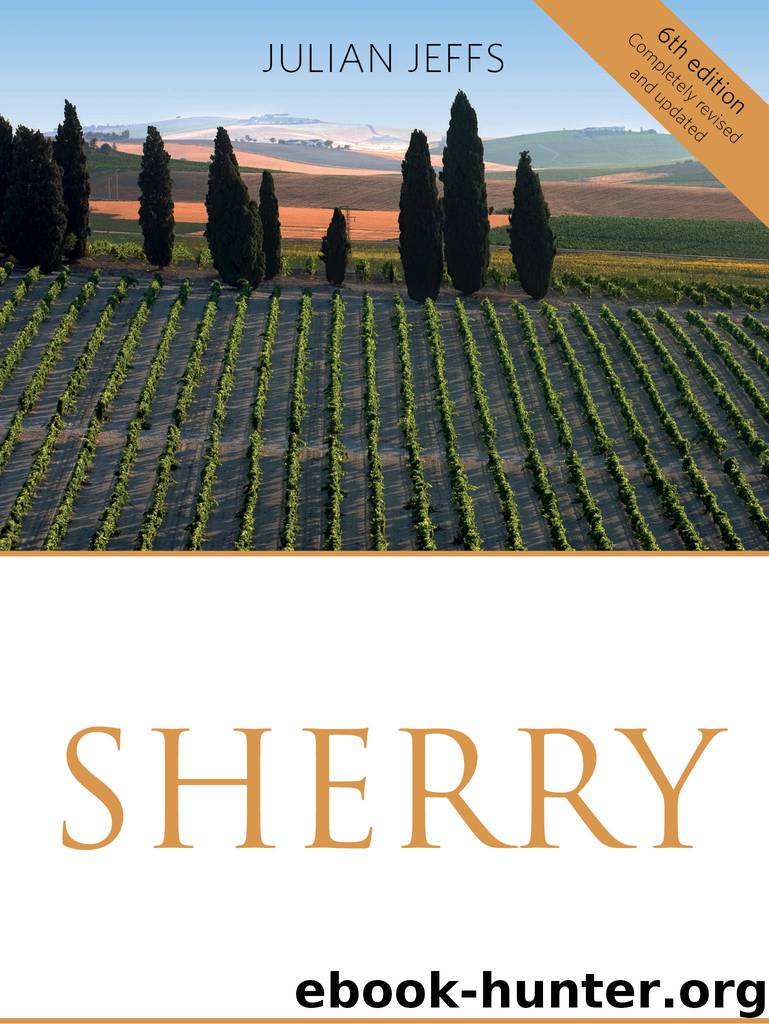Sherry by Julian Jeffs

Author:Julian Jeffs [Jeffs, Julian]
Language: eng
Format: epub
Publisher: Infinite Ideas
Published: 2016-10-06T04:00:00+00:00
A healthy vine grown to bear fruit for eating can undoubtedly live for several hundred years. Pliny wrote of vines six hundred years old; and in the patio of a school in Jerez that was formerly part of the Rivero bodegas, there was until the middle of the last century a Beba vine said to be over three hundred years old; its trunk was 43 cm wide and it was 3 metres high. The doors of Ravenna Cathedral are made of wood from a giant vine, and vines planted at Santa Barbara by the first Californian settlers grew to have a base circumference of 2.5 metres; in 1895 one of them yielded over 9,000 kilos of fruit. There were certainly vines over a hundred years old at Sanlúcar until the time of the phylloxera, and the great Black Hamburg at Hampton Court, planted in 1768, is still giving a full yield of fruit. In fact, if carefully tended, a vine goes on almost for ever and old vines give excellent wines, although the yield drops and eventually becomes uneconomic. Before the phylloxera, the useful life of vines in the sherry area varied between fifty and eighty years, and they never gave first-class wine until they were twenty or twenty-five years old; but the grafted vines have really productive lives of only twenty-five to thirty years, though some growers do not uproot them until they are forty-five years old or even older, giving a much reduced yield of top-quality must. To offset this a little they give up to 20 per cent more must17 and produce wine when they are only five years old. However, now there is overproduction and some shippers do not find it worthwhile to replant. For instance, Javier Hidalgo has vines that are over eighty years old.
Many vineyards are owned by shippers, who gain on the roundabouts what they lose on the swings, but some of the large vineyards are still controlled by landowners, who sell their produce by any of three methods: compra de uvas, compra de mosto, and a la piquera or al deslio. The first method, as a rule, is used by small growers, who sell their grapes as fruit delivered to the buyer’s press-house or to the cooperative. In the second method, the shipper buys the must as soon as it is prepared and gambles on its quality, trusting that the grower will not water it down, though some growers deliberately add a little water to must pressed from grapes that are very overripe. A shipper may also gamble on the quantity and buy the whole output of a vineyard early in the year, though this method is less usual. In the third, the shipper buys the must when it has been racked off the lees and fortified (see page 145) after fermentation has ceased, usually from a cooperative. The more important shippers generally buy what they need (if anything) by a combination of the last two methods.
In the winter the vines are in a state of suspended animation.
Download
This site does not store any files on its server. We only index and link to content provided by other sites. Please contact the content providers to delete copyright contents if any and email us, we'll remove relevant links or contents immediately.
Whiskies (Collins Gem) by dominic roskrow(42210)
101 Whiskies to Try Before You Die by Ian Buxton(42177)
Whiskies Galore by Ian Buxton(40329)
Craft Beer for the Homebrewer by Michael Agnew(17445)
Right Here, Right Now by Georgia Beers(3497)
Not a Diet Book by James Smith(2725)
Water by Ian Miller(2582)
The Coffee Dictionary by Maxwell Colonna-Dashwood(2531)
Kitchen confidential by Anthony Bourdain(2306)
Coffee for One by KJ Fallon(2007)
Smuggler's Cove: Exotic Cocktails, Rum, and the Cult of Tiki by Martin Cate & Rebecca Cate(1979)
Beer is proof God loves us by Charles W. Bamforth(1920)
Superfood Smoothie Bowls: Delicious, Satisfying, Protein-Packed Blends that Boost Energy and Burn Fat by Chace Daniella(1901)
Talking as Fast as I Can by Lauren Graham(1832)
Bourbon: A Savor the South Cookbook by Kathleen Purvis(1791)
A Short History of Drunkenness by Forsyth Mark(1718)
Eat With Intention by Cassandra Bodzak(1687)
Cocktails for the Holidays by Editors of Imbibe magazine(1625)
Colombia Travel Guide by Lonely Planet(1609)
